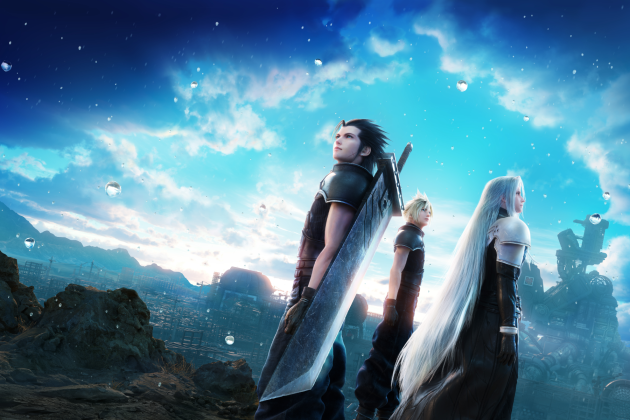‘Crisis Core: Final Fantasy VII Reunion’ Is a (Slightly) Updated Time Capsule From the Mid-2000s

In 1997, Japanese developer Square released a juggernaut with Final Fantasy VII, a game generally considered one of the greatest ever made. Ten years later, they’d expand that world with a prequel, Crisis Core: Final Fantasy VII, released for the PlayStation Portable. Relatively well-received at the time, that title would help keep the torch burning for fans as they anxiously awaited a next-gen remake of the original game (a desire created by Sony’s infamous PlayStation 3 tech demo tease and not delivered upon until 2020). That game, Final Fantasy VII Remake, was also announced as the first act of a trilogy, whose second part isn’t due out until Winter 2023. So – once again – Square Enix must release a holdover for fans. And once again, it’s Crisis Core.
That leads to this current-gen remake entitled Crisis Core: Final Fantasy VII Reunion. Set a few years prior to the events of Final Fantasy VII, Crisis Core follows (an awfully familiar looking) young man named Zack Fair who is part of SOLDIER, the evil Shinra Corporation’s army in the steampunk-inspired city of Midgar. However, he soon learns that Shinra has been harboring dark secrets of its own, and Zack becomes embroiled in the corporation’s sinister experiments.
More from Rolling Stone
'God of War Ragnarök' : An Emotional Odyssey Through Fatherhood
'Mario + Rabbids Sparks of Hope' is a Goofy Gaming Chimera (in the Good Way)
'The Last of Us Part I' : A Brutal Masterpiece Is Reborn for the PlayStation 5
Actually, “remake” might not be the most accurate term, but neither is “remaster.” The game sits somewhere in between. While playing Reunion, you can still feel its PSP origins — animations are a bit janky, especially in-game movement. Zack’s movement feels limited to the four cardinal directions, rather than a full range of motions. This becomes frustratingly noticeable in some instances, like while trying to run backward only for the game failing to register the input and continuing to run along in the previous direction.
![The janky dance. [Image courtesy of Square Enix]](https://s.yimg.com/ny/api/res/1.2/w9_lkQ7OMVxotXIqLls5FA--/YXBwaWQ9aGlnaGxhbmRlcjt3PTk2MDtoPTU0MA--/https://media.zenfs.com/en/rollingstone.com/ca89cccf5995f6f660e1d6d55d1736f5)
However, the real-time action gameplay remains as engaging as it was in the mid-aughts. Zack can utilize a variety of flashy sword attacks and magical spells to decimate his enemies. The biggest improvement is the “Digital Mind Wave” (DMW) implementation, which is a slot machine system where Zack can receive bonuses including an increase in his attack power, healing, and the ability to summon powerful allies to help him in battle.
The DMV rolls automatically and in the original game, it would pause the battle in order to show the player the result. In Reunion, though, this all plays out in real time. This tweak drastically improves the flow of gameplay and doesn’t grind battles to a screeching halt as the original did. This more visceral approach makes combat much more fun as players get to revel in continually hacking away at enemies.
The game’s structure includes ten story chapters, as well as a plethora of different optional quests and side missions which add a bit of world-building to the game. One example is a quest where a fellow Soldier wants Zack to cover his own missions because he lacks self-confidence and hopes to learn from him. Small quests like this breathe life into the world and, much like its big brother VII Remake, allows players to learn about Midgar’s citizens.
However, these missions can become repetitive, especially since they all primarily revolve around fighting groups of enemies in small dungeons. But it’s not all for nothing, as they generally offer great rewards for completion, such as more powerful weapons and additional slots for Zack to hold more equipment.
![Side quests have some benefit, even when redundant. [Image courtesy of Square Enix]](https://s.yimg.com/ny/api/res/1.2/19S5pR1dz4CGKkcnI8lZ0g--/YXBwaWQ9aGlnaGxhbmRlcjt3PTk2MDtoPTU0MA--/https://media.zenfs.com/en/rollingstone.com/b3ca2a930d4cc4fb76b474a4b1f44ccd)
While I played the PlayStation 4 version of Reunion, I’d recommend picking the game up on Nintendo Switch or PC (via Steam Deck) instead as the mission structure is a relic of the PSP handheld days, designed specifically for a pick-up-and-play gaming mentality.
Reunion also features a charming cast of characters, like Zack’s fellow SOLDIER operative, Genesis, who perpetually spouts corny poetry as dialogue. While a successful prequel, the story also stands apart, requiring no prior knowledge of Final Fantasy VII or familiarity with its characters to grasp, which helps with accessibility. However, diehard fans of the series will be rewarded as many legacy characters do reappear and play pivotal roles in the story.
Also revamped is the game’s soundtrack. Original composer Takeharu Ishimoto returns here to provide the soundtrack with a new arrangement, adding extra punch to audio with electric guitars and melodic strings.
![Pictured: A man in crisis, circa 2007. [Image courtesy of Square Enix]](https://s.yimg.com/ny/api/res/1.2/3UbK1yJMryMthZYLFIdw4w--/YXBwaWQ9aGlnaGxhbmRlcjt3PTk2MDtoPTU0MA--/https://media.zenfs.com/en/rollingstone.com/53228c76eff662ae30e8d54a77b61c0f)
Nothing better exemplifies Crisis Core: Final Fantasy VII Reunion as a time capsule peering into 2007 than the fact that the protagonist openly sports a flip phone. With edges roughened by time, but still wholly functional, Square Enix has modernized just enough with Reunion, especially with its improved battle system, to make it a fun adventure worth revisiting.
Crisis Core: Final Fantasy VII Reunion launches Dec. 13 on PlayStation 4 & 5, Xbox One, Xbox Series X|S, Switch, and PC.
Related
'God of War Ragnarök' : An Emotional Odyssey Through Fatherhood
'Mario + Rabbids Sparks of Hope' is a Goofy Gaming Chimera (in the Good Way)
'The Last of Us Part I' : A Brutal Masterpiece Is Reborn for the PlayStation 5
Best of Rolling Stone

